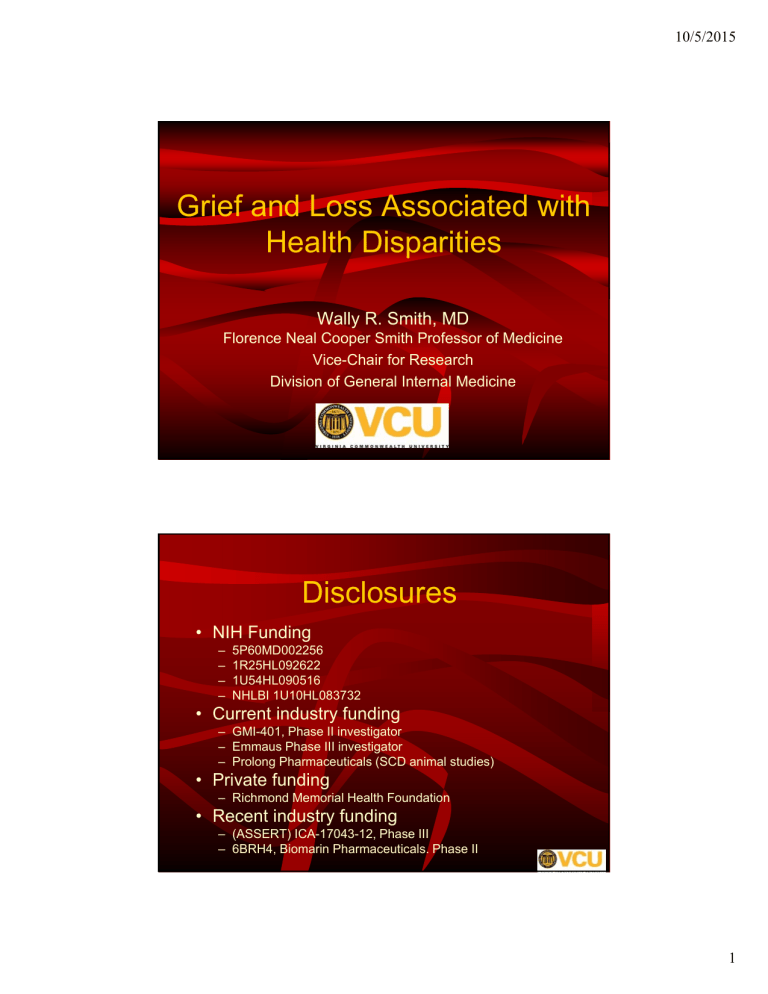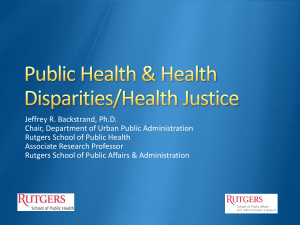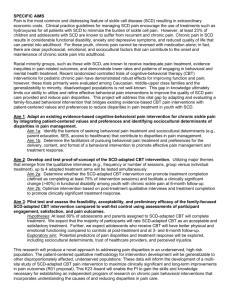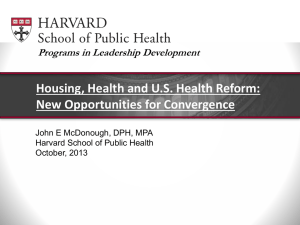Grief and Loss Associated with Health Disparities Wally R. Smith, MD

Grief and Loss Associated with
Health Disparities
Wally R. Smith, MD
Florence Neal Cooper Smith Professor of Medicine
Vice-Chair for Research
Division of General Internal Medicine
Disclosures
• NIH Funding
– 5P60MD002256
– 1R25HL092622
– 1U54HL090516
– NHLBI 1U10HL083732
• Current industry funding
– GMI-401, Phase II investigator
– Emmaus Phase III investigator
– Prolong Pharmaceuticals (SCD animal studies)
• Private funding
– Richmond Memorial Health Foundation
• Recent industry funding
– (ASSERT) ICA-17043-12, Phase III
– 6BRH4, Biomarin Pharmaceuticals. Phase II
10/5/2015
1
Learning Objectives
• Understand magnitude and causes of health disparities
• Identify sources of grief and loss in patients with sickle cell disease (SCD), an example of a disparities disease
• Identify challenges in assisting disparities patients and their families with grief and loss
• Suggest sources for help with disparities-related grief and loss
Case Study, JC
• 17yo AA with SCD.
• Admitted 8/3/09 for uncomplicated painful crisis (severe, “gnawing”, disabling pain, requiring opioids).
• Ran out of Tylenol #3, pain increased.
• Had Vicodin from prior crisis, took, but no relief.
10/5/2015
2
Past Medical History, JC
• Previously followed 4/16/1998-2000 in
Richmond.
– 3-4 clinic visits, 3 ED visits and two admissions.
– Followed 2000-2009 by hematologist at Portsmouth Naval Hospital, and
Newport News Virginia area.
• As of 8/3/2009, one painful crisis per month, yellow eyes “all the time.”
• Last hospitalization 5 months earlier.
Hospital Course 2009, JC
• Rxed with Morphine patient-controlled analgesia pump, antibiotics, oxygen, IV fluids.
• Discharged 3 days later.
• Appt to return “back” to pediatric SCD clinic in
20 days.
10/5/2015
3
Ensuing History, JC
JC Utilization 1998-2015
• Numerous ED visits, admissions
2009-2015.
• Few clinic visits.
• Turned out to be one of the top 5
SCD utilizers at the hospital.
50
45
40
35
30
25
20
15
10
5
0
Clinic visits
Inpatient stays
Emergency visits
23 hr obs
JC, August - September 2015
• Admission for sepsis (blood infection) and crisis
7/29/15-8/22/15.
– Infected Port-A-Cath (permanent central venous catheter), with unusual organisms (Cupravidus, Anthrobacter and Candida).
– Rx with Zosyn and Micafungin.
– R forearm abscess as well.
– 2 u PRBCs.
• ED visit 9/9/15 for pain
– resolved after 1-2 rounds of IV pain meds.
• SCD Clinic visit 9/17/15 (14 OPs fm 2012-15)
– Doing “ok”, exactly as in previous visits.
– Pain on 15 of last 30 days. Leg, lower back.
– Only takes pain meds (Dilaudid) on the days with pain.
10/5/2015
4
Course, JC, September 24 2015
• Arrived in cardiac arrest 9/24/15. Arrest witnessed by family.
– “Sitting on couch, had a bowel movement on self.” Father drove patient to the ED immediately.
– IV was already in arm, appears to have been at another hospital earlier 9/23/15.
– Had been seen in ED two days earlier with crisis and a UTI. Sent home.
• Expired
– Despite 90 mins of CPR, 3 units blood transfusion, consideration of
ECMO, multiple rounds epinephrine and amiodarone for cardiac arrest, calcium, bicarb for presumed hyperkalemia, dextrose X2 for initial glucose of only 17. Family consented to an autopsy.
10/5/2015
MAGNITUDE AND CAUSES OF
DISPARITIES
5
Health Disparities
• “ Health disparities are differences in the incidence, prevalence, mortality, and burden of diseases and other adverse health conditions that exist among specific population groups in the United States.”
– Ca 1999
Health Disparities
Populations
• “ A population is a health disparity population if there is a significant disparity in the overall rate of disease incidence, prevalence, morbidity, mortality or survival rates in the population as compared to the health status of the general population.
”
– Ca. 2000 Minority Health and Health Disparities
Research and Education Act United States Public Law
106-525 (2000), p. 2498
10/5/2015
6
Health Care Disparities
• Healthcare disparities refer to differences in access to or availability of facilities and services.
• Health status disparities refer to the variation in rates of disease occurrence and disabilities between socioeconomic and/or geographically defined population groups.
– [Both definitions are from the 2009 Medical Subject
Headings (MeSH).]
Health Care Disparities
Relatively Newly Discovered
• A newly recognized component of health disparities
• Have received increased attention
• Emerging consensus -- without new and more effective interventions, health care disparities will be difficult to eliminate
– [ [i] Byrd WM. Race, Biology, and health care: reassessing a relationship. J Health Care Poor Underserved.
1990;1:278-96.
– [ii] Black-white disparities in health care. JAMA. 1990 May 2;263(17):2344-6.
– [iii] Smedley BD, Stith AY, Nelson AR, eds. Unequal Treatment: Confronting Racial and Ethnic Disparities in Health
Care. Washington, DC: National Acad Pr; 2002.
– [iv] American College of Physicians. Racial and ethnic disparities in health care: a position paper of the American
College of Physicians. Ann Intern Med. 2004;141:226-232.
– [v] Lavizzo-Mourey R, Lumpkin JR. From unequal treatment to quality care. Ann Intern Med. 2004;141:221.
– [vi] King TE, Wheeler MB. Inequality in health care: unjust, inhumane, and unattended! Ann Intern Med.
2004;141:815-817.
10/5/2015
7
Unconscious Bias
• Implicit Bias among Physicians and its
Prediction of Thrombolysis Decisions for
Black and White Patients
– Distinct from conscious (explicit) bias
– may contribute to racial/ ethnic disparities in use of medical procedures such as thrombolysis for myocardial infarction
• Green AR, Carney DR Pallin DJ, Ngo LH, Raymond KL Iezzoni LI,
Banaji MR. JGIM 2007;22:1231–1238.
10/5/2015
This black 6 year-old Virginian is more likely to die than this white 6 year-old, and will be more likely to die throughout life (until he’s 80)
THE EXTENT OF DISPARITIES
8
Virginia Black/White
Mortality Ratios, 1997-1999
2.2
2
1.8
1.6
1.4
1.2
1
All 25-44 45-54 55-64 65-74 75-84 85+
Data, NCHS Beyond 20/20 Browser
900
800
Death rate per
100,000 population
(1998)
700
600
500
400
300
200
100
0
Overall
U.S. Mortality by
Race/Ethnicity
White Black Hispanic Native
American
Data Source: National Vital Statistics System (NVSS), CDC, NCHS, 1998.
Cancer
Diabetes
Coronary dz
Stroke
Infant Mortality
10/5/2015
9
Social Determinants of Health
Disparities
• Psychological stress, differences among races, classes
– often environmentally determined
– also perhaps culturally determined
• Racism-induced stress
• Socioeconomic differences
– often result from racial discrimination
– may exist within racial groups
– Affect health perhaps by way of environmental stress
• Socio-political forces
– affect access to and quality of medical care
– determine practice variation
Social
Determinants of Health
• previous curricula made that assumption.
[i]
• [i] Byrd WM. Race, Biology, and health care
Health Gap is Widening
• Number of Americans who are vulnerable to suffering the effects of heath care disparities will rise over the next half century.
• Some ethnic minorities, as well as low-income families of whatever race or ethnicity, tend to be in poorer health than other Americans.
– National Healthcare Disparities Report Summary
10/5/2015
10
US Population Becoming
Increasingly Diverse
• Some racial and ethnic minorities growing >> majority whites.
• Ethnic minorities =50% by 2050*
– Nearly 1 in 2 Americans will be a member of a racial or ethnic minority— i.e., black, Hispanic, Asian, or American
Indian—by the year 2050.
– *US Census estimate
Summary Points Regarding Health
Disparities
• We are surrounded by health disparities
– but we may not be aware of causes and extent of disparities
• Social determinants of health as major determinants of health disparities
• Distinction between health status disparities and healthcare disparities
• Implicit (unconscious) bias as a newly discovered determinant of health care disparities
• Racial and ethnic groups vary by geography
• Disparities are widespread
– Getting worse as population becomes more diverse toward majority-minority
– Going to become a national epidemic by 2050.
10/5/2015
11
10/5/2015
SOURCES OF GRIEF AND
LOSS IN DISPARITIES
DISEASES
Sources of Grief and Loss:
Sickle Cell, the Disease
• Pain
• Responses to pain
– Grievous, humiliating encounters w/ health care professionals
• Fatigue
• Organ failure
• Early death
12
Sickle Cell Disease
• Genetic hemoglobinopathies
(4 prevalent in US)
• 90-100,000 Americans, various ethnicities
• Extreme, unpredictable pain
• Vaso-occlusive phenomena
• Bone marrow/stem cell transplants curative Rx
• Hydroxyurea remittive Rx
• Oxygen, fluids, (exchange) transfusion, prescription opioids, supportive therapy
10/5/2015
Animation Courtesy of Betty Pace, MD., Southwestern Comprehensive Sickle Cell Center Dallas, TX.
13
Pain in Sickle Cell Disease
• Hallmark of disease
• Ubiquitous
• Present throughout life
• Variable
• Genotype and biological traits explain only part of these variances
Differences in Sickle Cell
Pain and Cancer Pain
Cancer Pain
Non-ischemic
Continuous
Progressive
Predictable
Terminal event
Not questioned
Many objective correlates
May be absent
Few to no ER visits
Older adults
Longitudinal specialty care
Sickle Cell Pain
Ischemic
Intermittent
Remitting
Unpredictable
Throughout life
Questioned by MDs
Few objective correlates
Prominent feature of disease
Frequent ER visits
Children, young adults
Episodic care
10/5/2015
14
Pain in Sickle Cell
Epidemiology Study
• Measured pain and response to pain in sickle cell disease
• Explained differences in pain and response to pain
PiSCES
Pain Intensity On Crisis Vs Noncrisis Vs. Utilization Days
Above water 3.5%
Intensity Mean
Dev
Utilization
6.5
2.3
Submerged
13.1%
Crisis w/o utilization 5.5
2.1
Pain w/o crisis, util. 4.2
2
39.3%
0 0 44.1% No Pain
*Percentage of days. Utilization= utilization with or without crisis or pain;
Crisis= crisis without utilization; Pain= pain without crisis or utilization
Adapted from Smith WR, et. al. Ann Intern Med 2008 Jan 15, 148(2):94-101
10/5/2015
15
Sources of grief and loss-
Treatments
• Emergency room visits, hospitalizations
• Opioid side effects
• Hydroxyurea– ?loss of reproductive capacity
• Bone Marrow transplantation – possible death vs. cure
Sources of Grief and Loss—
Responses of Others to the Disease
• Disbelief of Pain, fatigue, symptoms
• Avoidance, stigmatization
• Unwelcome, hostile health care provider responses
• Underprescription of opioids
• Suspicion of overuse or diversion of opioids
• Provider Uncertainty of appropriate management
• Huge disparities in funding for treatment and research
10/5/2015
16
Pain vs Opioid Use, PiSCES
100%
90%
80%
70%
60%
50%
40%
30%
20%
10%
0%
85
103
Mean Pain
Intensity on
Pain Days (SD)*
Percent Pain
Days (SD) +
LA opioid (+/any analgesic) 4.8 (1.5)
SA opioid (+/non-opioid)
4.1 (1.4)
Non-opioid only
3.0 (1.2)
81.9 (25.4)
51.9 (35.3)
16.8 (23.3)
LA=long-acting, SA=Shortacting.
*Mean pain on pain days, overall ANOVA p<0.0001.
All paired comparisons statistically significant except none vs non-opioid and none vs SA opioid.
+ Percent pain days, overall
ANOVA p<0.0001.
All paired comparisons statistically significant except none vs. non-opioid
21
10
Patients
None 2.8 (2.0) 12.3 (30.9)
• Fewer (38.8%) used LA opioids (w or w/o other analg’s) than used SA
(47.0% w or w/o non-opioids)
• 9.6% only non-opioid, 4.6% none analgesics
• Pain intensity, freq higher with LA or higher total opioid
– Smith WR, et al. J
Opioid
Manag. 2015 May-Jun;11(3):243-53. doi: 10.5055/jom.2015.0273. PMID: 25985809
SCD: A Double Whammy
• Members of a Health Disparities population
• Suffer Chronic Non-Cancer Pain (CNCP)
– CNCP Common
– Significant burden to adult patients
– Known to lower quality of life
–
–
Kowal, John, et al. "Self-perceived burden in chronic pain: Relevance, prevalence, and predictors." Pain 153.8 (2012): 1735-1741.
Ferrell BR. The impact of pain on quality of life. Nurs Clin North Am. 1995;30(4):609-24.
– May be poorly managed
• anxiety and distress related to subsequent treatment
• negative long-term psychological effects
10/5/2015
17
Underprescribing, Vicious Cycle
• Perception of a high prevalence of addiction inadequate analgesia.
– 53% of ED physicians , 23% of hematologists said > 20% of adult SCD
“addicted”
– 22% of ED physicians 9% of hematologists said > 50% addicted [22].
• SCD pts may be under-medicated in the ED [25, 26]
– may report more pain and have increased rates of hospital utilization.
• Undertreatment behaviors of pseudoaddiction
– (drug-seeking behaviors that resolve when pain is adequately treated) which are often misunderstood and reinforce the misconceptions of addiction [27. ]
• Inadequate analgesia communication barriers, ↓ trust in the provider.
– Most patients have had negative experiences in the acute care setting
– Many report providers underprescribed
– Many report did not seem to understand how much pain they were experiencing.
Results: Illustrative quotes
• Participant #10: “Yeah, I actually, just, stopped taking it… kinda worried about my dependency”.
• Shows an unwillingness to take opioids, for fear of being dependent
• Participant #16: “You know it slows me down… or makes me drowsy, if I have, you know things to do”.
• Illustrates patients’ dislike of side effects of opioids, interference with planned activities
• Participant #20: “maybe not taking it…the kids take advantage…’cause they know it makes me drowsy, and it puts me to sleeps so they… take advantage”.
• Illustrates patient caught between needing to use opioids for pain control and not wanting opioids for various reasons.
• Hypothesis: this can lead to various levels of adherence over time
10/5/2015
18
Sickle Cell vs. Cystic Fibrosis
Variable
US prevalence a
Federal support
NIH fiscal-year 2004 funding, in millions of dollars b
NIH funding per person with disease, $
No. of federal grants
No. of grants funded in 1968 c
No. of grants funded in 1972, after Sickle Cell Anemia Control Act d
No. of grants funded in 2004
Private philanthropic support, $
Cystic Fibrosis Foundation 2003 annual revenue e
Sickle Cell Disease Association of America 2003 annual revenue, f
Revenue per person affected with disease
Total NIH and private support, in millions, $
SCD
80000
90
1125
22
215
331
$498,577.00
6
90.4
Cystic Fibrosis
30000
128
4267
65
80
459
$152,231,000.00
5074
280.2
• Lauren A. Smith, Suzette O. Oyeku, Charles Homer, and Barry Zuckerman
Sickle Cell Disease: A Question of Equity and Quality
Pediatrics, May 2006; 117: 1763 - 1770.
Federal government requests for applications funded for SCD and CF: 1975-2004
10/5/2015
Smith, L. A. et al. Pediatrics 2006;117:1763-1770
Copyright ©2006 American Academy of Pediatrics
19
10/5/2015
Dying in the City of the Blues—
SCD as a Disparities Disease
• “…in the 1960s the history of sickle cell disease also intersected with the national politics of race, inequality, nad health care in America.”
– Wailoo K, Dying in the City of the Blues, p. 7
20
SCD and 1960s US Congressional and Presidential Politics
• A “neglected disease”.
• A disease of people whose “pain and suffering’ had been ignored for too long.
• Repetitive painful episodes (crises) fit neatly with the politics of consciousness-raising.
– Wailoo K, Dying in the City of the Blues, p. 7
SCD As a Disparities
Disease
• “To invoke the pain and suffering of the sickle cell patient was to dramatize the long-ignored social condition of black Americans and to give impetus to social activism.”
– Wailoo K, Dying in the City of the Blues, p. 7
10/5/2015
21
Dying in the City of the
Blues
• Disease as a commodity
– emphasizes [sickle cell disease’s] place in a network of exchange relationships
• “much like any object, the disease concept and the illness experience acquired value and could leverage resources, money, or social concessions"
10/5/2015
CHALLENGES IN ASSISTING
DISPARITIES PATIENTS WITH
GRIEF AND LOSS
22
The Goal
• As clinicians, our bottom line goal is to optimize patient outcomes through effective treatment plans for all of our patients including those from socially and culturally diverse backgrounds
Identifying (Sometimes
Hidden or Unrecognized)
Losses in Disparities Patients
• Lost quality of care
• Lost respect, prestige, dignity, power
• Lost income
• Lost relationships from disease
• Lost lives (unexpected, early death)
10/5/2015
23
Could Victims of Disparities be
Suffering “Complicated Grief”?
• Characteristic symptoms include intense yearning, longing, or emotional pain, frequent preoccupying thoughts and memories of the deceased person, a feeling of disbelief or an inability to accept the loss, and difficulty imagining a meaningful future without the deceased person.
– M. Katherine Shear, M.D., N Engl J Med 2015; 372:153-160
January 8, 2015
Example: SCD Health Outlook--
Influences on Pain interactions
• Negative attitudes Patients loathe/avoid coming to busy EDs, treat even severe pain at home.
– Negative attitudes and medical care opinions based on previous experiences [28].
– Pts report being treated rudely, or delays, avoid the ED until extreme need provokes utilization [27, 29].
• Documented disputes between patients and staff about patient behaviors that raised staff concerns about analgesic misuse. [30]
• SCD pts rate satisfaction / humaneness of care significantly << asthma pts. [29]
10/5/2015
24
Bibliography: Specific
Difficulties In SCD Pain
Management
• 22. Shapiro BS, Benjamin LJ, Payne R, Heidrich G. Sickle cell-related pain: perceptions of medical practitioners. J Pain Symptom Manage
1997;14(3):168-74.
• 26. Shapiro BS. The management of pain in sickle cell disease. Pediatric clinics of North America 1989;36(4):1029-45.
• 27. Murray N, May A. Painful crises in sickle cell disease--patients' perspectives. Bmj 1988;297(6646):452-4.
• 28. Coulton C, Frost AK. Use of social and health services by the elderly.
Journal of health and social behavior 1982;23(4):330-9.
• 29. Bobo L, Miller ST, Smith WR, Elam JT, Rosmarin PC, Lancaster DJ.
Health perceptions and medical care opinions of inner-city adults with sickle cell disease or asthma compared with those of their siblings. Southern medical journal 1989;82(1):9-12.
• 30. Elander J, Lusher J, Bevan D, Telfer P, Burton B. Understanding the causes of problematic pain management in sickle cell disease: evidence that pseudoaddiction plays a more important role than genuine analgesic dependence. J Pain Symptom Manage 2004;27(2):156-69.
Recent Narrative: Live in
Fear and Stigma
• Doctor says to parents “your child will die before age 20”
• Child and parents go inward, waiting for the end one day.
– They don’t talk about what’s wrong or what they’ve been told. It’s a dirty secret.
• Limits awareness
10/5/2015
25
Narrative: Wondering if it’s the End
• “I (my child) was fine for a long time. Now I’m sick all the time.
I’m losing control of life. Am I going to die soon (like they told me once)? Can you do anything to make life better than this?”
Narrative: Gotta Stay in the
Closet
• “I don’t go to MCV. They will tell all of my business.”
– The dirty secret of pain of SCD
– Employers, other patients with SCD will know
10/5/2015
26
Cultural Gaps Must be Bridged to
Assist Grieving Disparities
Patients
• Cultural insensitivity to losses
– Can’t identify with some losses
• Language and non-verbal communication gaps
– “Aggressive, Angry” behavior
• Must understand the source, how to respond
Patient Centered Care:
The Three Perspective Approach
+ Patient:
+ Identify meaning of illness
(Kleinman Questions)
+ Social Context ROS
+ Physician
+ Society
Patient Centered Care Plan
(that will Optimize Patient Outcomes)
54
10/5/2015
27
Kleinman’s Questions &
The Patient Centered Method
• Offers structure to the patientphysician interview
• An excellent way to begin building your treatment agreement
• Kleinman’s questions are often referred to as the explanatory model
Kleinman A. Eisenberg L, Good B. Culture, illness, and care: clinical lessons from anthropologic and cross-cultural research. Ann Intern Med. 1978;88:251-8.
55
Kleinman Questions
1) What do you think has caused your problem?
2) Why do you think it started when it did?
3) What do you think your sickness does to you? How does it work?
4) How severe is your sickness? Will it have a short or long course?
5) What kind of treatment should you receive?
56
10/5/2015
28
Kleinman Questions
Continued
6) What are the most important results you hope to receive from this treatment?
7) What are the chief problems your sickness has caused for you?
8) What do you fear most about your sickness?
57
10/5/2015
SOURCES OF HELP WITH
DISPARITIES-ASSOCIATED
GRIEF AND LOSS
29
Health Professionals
• Palliative Care Team
– Helpful in my setting with adults
• Mental Health Professionals
– Almost nonexistent for many adults suffering disparities
Back to “Complicated
Grief”: Rx
• Randomized, controlled trials provide support for the efficacy of a targeted psychotherapy for complicated grief that provides an explanation of this condition, along with strategies for accepting the loss and for restoring a sense of the possibility of future happiness.
– M. Katherine Shear, M.D., N Engl J Med 2015; 372:153-160
January 8, 2015
10/5/2015
30
10/5/2015
VCU Clinic Staff
3 Adult Physicians/physicians assistants
2 pediatric Physicians/physicians assistants
Pediatric Social worker
Pediatric educational coordinator
Pediatric psychologist
Biological Variables
Genetically Mediated Susceptibility
Psychosocial-Cultural Variables
Socioeconomic Status
Awareness
Preferences
Beliefs about Health
Beliefs about health care system
Social Support
Self Efficacy
Access Variables
Insurance
Geographic Proximity to Care
Temporal Access ( wait times )
Transportation
Physician/Health System Variables
Treatment Disparities
Cultural Incompetence and Insensitivity
31





